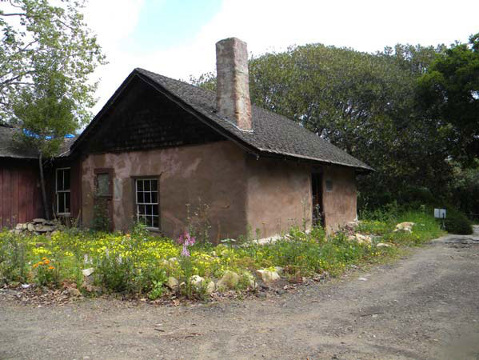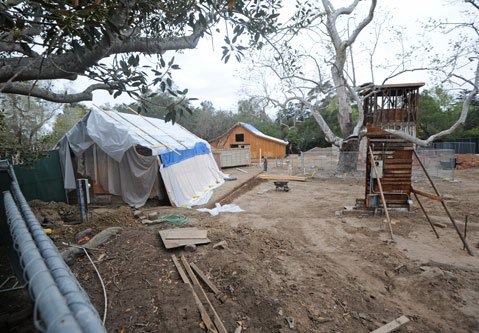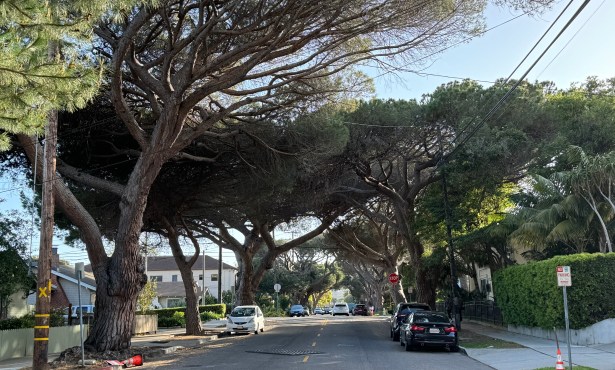What’s the Point of Landmarks If They’re Not Protected?
Supervisors to Decide Fate of Landmarked Hosmer Adobe

In the fall of 1993, through one of those know-someone-who-knows-someone chains of acquaintance that happen naturally in Santa Barbara, I fell into the role of renter and de facto caretaker of the Hosmer Adobe on San Ysidro Road in Montecito. I was in my early twenties, working as a reporter at The Independent making less than $20,000 a year — not exactly the typical resident of Montecito.
When The Independent ran the piece Adobe House in Jeopardy on February 27, my email inbox blew up with people outraged and sad about what seems to be happening to the Hosmer Adobe.
My roommate Kirsten and I were the first renters to move into the adobe after the elderly owner left for health reasons. She had lived there since the 1950s, and the property had been in her family for more than 100 years. If you doubted that, the main room was stuffed with broken furniture, and News-Press back issues going all the way to the 1950s to prove it. Everything was covered by a thick coat of dust. But underneath all that there was also a grand piano. And the walls were lined with original early California art. Once we settled in, the Hosmer and its surrounding land was a beautiful place to live. I wrote my first book and dozens of magazine articles in my “office” at the top of the three-story water tower.
I slid easily into Montecito life. Most mornings I’d walk with my dog over to Pierre LaFond and drink coffee with neighbors like T.C. Boyle and John Winters. I remember one time sitting down for breakfast and realizing that the table next to me was occupied by Mick Jagger and Charlie Watts, taking a break from the Rolling Stones Voodoo Lounge tour. But it was Montecito’s history and landscape that really captivated me.
I’d never lived in a 160-year-old house before. I used to baffle visitors by telling them that the house was built in Mexico. They’d ask, if that was true, then how was it moved here? And I’d tell them, no, Mexico moved away in 1848, and the house stayed behind.
The oldest part of the house is a large adobe room built in 1830. I’m told it was originally a bunkhouse for vaqueros guarding the cattle pens from hungry grizzlies coming down out of San Ysidro Canyon at night in search of a meal. There was a horno-style fireplace in the corner that still worked. The fireplace looked original but was actually built as a repair after the 1925 Santa Barbara earthquake cracked open that corner of the room.
The other wing of the house, with two bedrooms, a kitchen, and a dining room, looked like typical cottage construction, but closer inspection revealed that walls were virgin old-growth redwood. To replicate it today would be impossible. The wood alone would cost a fortune, never mind the environmental implications.
And like so many places in Santa Barbara, the Chumash had been there long before. Out behind the house in a small drainage covered by oaks I found a several Chumash grinding stones.
I lived in that house for three years, during which time I slept through the Northridge earthquake in the adobe, which barely shook. I hosted countless dinners and some legendary parties. The house had been gathering place in the old 1950s and ’60s bohemian era. The owner’s son told me about visits from Diego Rivera and other artistic luminaries. With us living there, the adobe really came back to life after a period of dormancy. About the only thing that the Mountain Drive bohemians did that we didn’t do was invent the hot tub.
People came and went freely. I had a pretty generous open-door policy, and there was plenty of room for guests. On any given evening you could find my beach lifeguard friends grilling lobster over the fire pit or a touring musician spending the night after performing at the County Bowl. Once in a while, former 1st District supervisor Naomi Schwartz knocked on my door, and we’d have a cup of tea on the screen porch.
Certain places become centers for artistic creativity. The adobe was one of those places. During the drought-shattering downpours in January 1995, I got a call from my friend, the musician Ellen Turner. She was stranded without much food or company at her house way up in Toro Canyon. I drove through floodwaters and over landslides in my Landcruiser to retrieve Ellen and bring her down to the adobe. She stayed for a week and composed an entire album’s worth of songs on the adobe’s piano. Years later, I was driving around Los Angeles listening to KCRW when one of those songs came over the radio, taking me right back to that room and time.
I left Montecito and the adobe when I met the woman who would become my wife and moved to San Francisco to be with her. But I handed the adobe off to a friend who lived there in a similar style. And when he left he did the same; a tradition that continued pretty much without interruption up until the property was sold for $750,000 in 2009 to Funk Zone developers Katie Hay and her brother, Brian Kelly.

The last time I was at the Hosmer Adobe was a couple years ago. I’d been mountain biking up in Romero Canyon and dropped by to see what was going on with the place. I had no idea it had changed hands. I pulled into the driveway like I’ve done a million times before and let myself through the gate. But when I walked up I could tell something wasn’t right. Windows were open, and the main door into the house was completely gone. I shouted out to see if anyone was inside but got no answer. The house looked like it had been left open to the elements with the hope of accelerating the natural process of entropy that happens when any house is left vacant.
Santa Barbara is famous as a place of beauty and substance. It has significance and influence far beyond the size of its population. And I don’t think it has that reputation because of the billionaire investment bankers and movie stars who jet in to buy their third or fourth vacation home. There’s nothing particularly original or inspiring about being the East Hampton of the West Coast. I like to think that when people around the world dream about Santa Barbara, it’s because of the underlying current of history and culture that permeates this place.
The fact that the Board of Supervisors is even considering letting a developer demolish the Hosmer Adobe raises the question of what’s the point at all of dedicating certain structures as historic landmarks only to willfully allow them to decay and be torn down? An earlier makeup of the Board of Supervisors thought the adobe was an important enough cultural resource that those supervisors even wrote it into the Montecito Community Plan, with specific language saying that “the Hosmer Adobe shall be preserved as a community resource and shall not be removed or damaged.” That’s not just a warm sentiment. The Montecito community plan has force of law. And it’s correct; the Hosmer Adobe really should be preserved as a community resource. It should not be removed or damaged.
Which is why the supervisors should vote at their hearing on May 6 to prohibit the current owners from tearing it down under the guise of creating a “replica.”
The plan to restore the adobe by razing it and creating a convincing replica has a lot of problems. But the most significant one is this: A replica does not retain County Historic Landmark status. And, as a result, all the current building restrictions on the property are likely to fall away.
The current owners are very savvy. They knew exactly what they were getting into when they bought a historic dwelling. But they are real estate developers. It’s their job to find the legal and zoning angles and to push the boundaries of what’s allowable in the name of profit. The financial math that would attract them to the property is pretty straightforward: Buy a half-acre Montecito property encumbered by a historic landmark for $750,000, putting 20 percent down; after neglecting the buildings for four years, petition the county to let you raze the historic structures because they are now “irreparable” and build a “replica.” Once that’s done, sell the newly unencumbered half-acre property and house for $3.5 million-$4 million because the new owner doesn’t have to deal with any historic landmark restrictions. Nice return on investment for Hay and Kelly. But the community loses a tremendous historic and cultural asset.
I can no more blame real estate speculators for speculating than I would have blamed the grizzlies that used to come down out of San Ysidro Canyon looking for a tender steer. It’s what they do. But by the same token, it is the job of the County Historic Landmarks Advisory Commission, the County Planning Department, and the Board of Supervisors to push back against the relentless pressure of speculation and development. Otherwise, the Hosmer Adobe won’t be the last historic landmark to suddenly, mysteriously, be declared beyond saving, all so that someone can tear it down for a quick profit.



